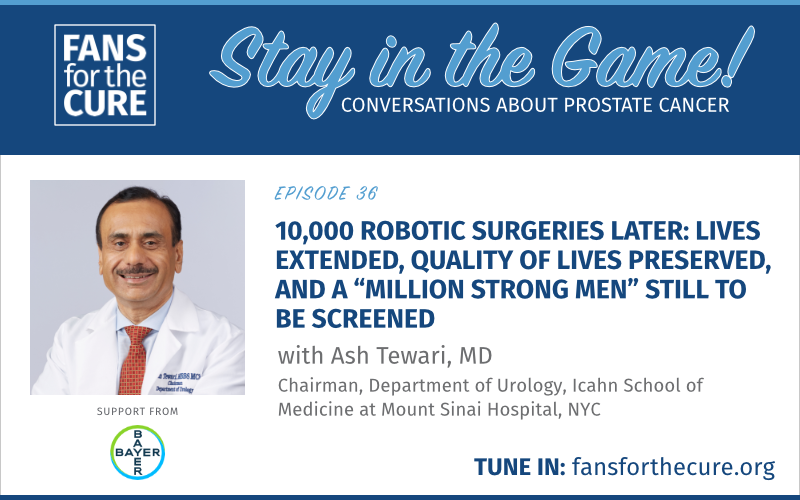The American Cancer Society estimates that in 2022, over 268,000 men will find out that they have prostate cancer, with about 34,500 deaths resulting directly from the disease.
The good news is that an estimated 3.3 million Americans are prostate cancer survivors, encompassing 43% of all male cancer survivors in the US.(i) The average age at diagnosis is 66 years, with five-year relative survival rates that exceed 99%. For all prostate cancer diagnoses combined, the 10-year and 15-year survival rates are 98% and 91%.(ii) These encouraging survival statistics are in large part a result of early detection and effective treatment. It is clear that prostate cancer survivorship extends well beyond treatment of the disease, and survivors must stay attuned to their particular health needs.
Prostate Cancer Recurrence
Primary treatments for prostate cancer typically involve radical prostatectomy and/or radiation therapy, providing a cure for a large proportion of patients. Recurrence following these treatments does occur, and physicians use prostate-specific antigen (PSA) levels in the blood to monitor for relapse. Factors predicting a recurrence include the pretreatment PSA, anatomic extent of cancer, and Gleason score.
Recurrence rates following local treatment for prostate cancer range between 19-35% at 10 years and depend on the aggressiveness of the cancer.(iii) Initial detection of recurrence is identified by arise in PSA, which is typically the first sign the cancer may have come back. Prostate cancer recurrence can occur locally at the prostate bed or distantly in the lymph nodes, bones, or other organs. The definition of recurrence varies based on the type of initial therapy. For radical prostatectomy, a recurrence is defined by a blood PSA > 0.2, while a recurrence following radiation therapy is a PSA rise of >2 above your lowest level.(iv)
Once a recurrence is detected treatment options include observation, salvage radiation, systemic androgen deprivation, chemotherapy, targeted therapy, or a combination of treatments. Survival rates following a recurrence vary significantly based on PSA levels, pretreatment factors, time to recurrence and pathologic stage, with several nomograms available to predict outcomes.(v) Fortunately, a PSA rise does not necessarily predict metastases, and the clinical course is often very prolonged with durable survival in many patients.
Living Cancer-Free
An important component of successful prostate cancer treatment is regular follow-up appointments and testing. This will ensure that should there be a recurrence of prostate cancer, it will be detected in its earliest and most treatable stages.
Post-Treatment Surveillance
There are many opinions on the best way to watch for any signs of recurrence, but all recommended protocols include close monitoring of a simple blood test called a PSA. In the case of surgery to remove the prostate, the PSA is expected to become zero (<0.05 on most lab testing). However, if radiation was used to treat the disease, the PSA will decrease, but may not reach zero. The most important aspect of monitoring the PSA after treatment is to ensure that the value is not increasing, which may suggest that the disease has returned.
One of the commonly utilized guidelines for prostate cancer surveillance after treatment comes from the National Comprehensive Cancer Network (NCCN). NCCN recommends checking the PSA every 6-12 months for 5 years, then annually thereafter. Urologists will work with their patients to set up an appropriate surveillance schedule.
Enhancing Survivorship
While no guidelines exist to prevent recurrence of prostate cancer, many recommend the same nutritional guidelines recommended to prevent cancer. Studies have suggested a clinical benefit to a plant-based, whole-food diet, low in saturated fats combined with exercise and stress reduction. Others have suggested a clinical benefit to Pilates, relaxation techniques, green tea, qigong, massage, and avoidance of nonprescribed supplements. Popular cancer prevention techniques that have not shown benefit include soy, omega 3 fatty acids, milk thistle, hypnosis, and pomegranate. Although there is limited data looking at these survivorship techniques, it is recommended that prostate cancer survivors adopt a healthy lifestyle utilizing healthy diet, exercise, and stress management.(vi)
Remission
Following therapy for prostate cancer, whether it be prostatectomy or radiation, the PSA is used to assess for recurrence. A patient is thought to be in remission based on PSA level, with different definitions depending on the initial treatment. After radical prostatectomy, patients with an undetectable PSA are thought to be in remission. Conversely, the definition of remission is more difficult following radiation, as the PSA level is most often detectable following treatment. Although lower PSA nadirs (lowest level it drops) have been shown to have better outcomes, no absolute level can be used to assess success. Following radiation, recurrence is defined as a PSA rise of greater than 2 above the nadir. Remission does not necessarily mean the cancer is cured, and it is important for patients to have close surveillance with routine PSA testing.
(i)i Miller KD, Siegel RL, Lin CC, et al. Cancer treatment and survivorship statistics, 2016. CA: a cancer journal for clinicians. https://www.ncbi.nlm.nih.gov/pubmed/27253694. Published July 2016.
(ii) Siegel R, DeSantis C, Virgo K, et al. Cancer treatment and survivorship statistics, 2012. CA: A Cancer Journal for Clinicians. 2012;62:220-241.
(iii) Freedland SJ, Humphreys EB, Mangold LA, et al. Risk of Prostate Cancer–Specific Mortality Following Biochemical Recurrence After Radical Prostatectomy. Jama. 2005;294(4):433. doi:10.1001/jama.294.4.433.
(iv) Cookson MS, Aus G, Burnett AL, et al. Variation in the Definition of Biochemical Recurrence in Patients Treated for Localized Prostate Cancer: The American Urological Association Prostate Guidelines for Localized Prostate Cancer Update Panel Report and Recommendations for a Standard in the Reporting of Surgical Outcomes. Journal of Urology. 2007;177(2):540-545. doi:10.1016/j.juro.2006.10.097.
(v) For more information, see https://www.mskcc.org/nomograms/prostate/biochemical_recurrence..
(vi) Zuniga KB, Chan JM, Ryan CJ, Kenfield SA. Diet and lifestyle considerations for patients with prostate cancer. Urologic Oncology: Seminars and Original Investigations. 2019. doi:10.1016/j.urolonc.2019.06.018.


